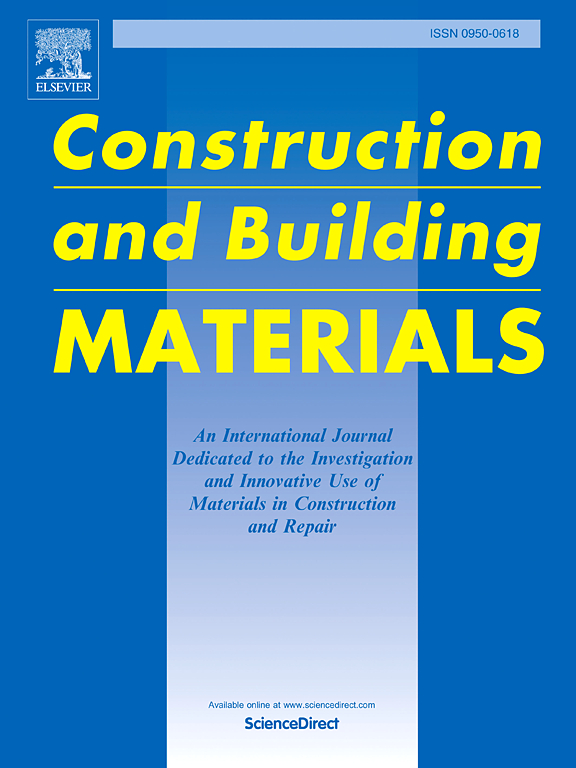评估用硫铝酸盐水泥固化城市固体废物焚烧飞灰的生态砂浆的性能和可持续性
IF 7.4
1区 工程技术
Q1 CONSTRUCTION & BUILDING TECHNOLOGY
引用次数: 0
摘要
城市固体废物焚烧飞灰(MSWI-FA)含有重金属、二恶英和有害物质,属于危险废物。使用螯合剂进行固化/稳定化(S/S)处理因其效率高而得到广泛应用。然而,这种处理方法的固化成本较高。本研究尝试使用硫铝酸盐水泥(SAC)固化 MSWI-FA。首先,研究了不同的 MSWI-FA 替代率对生态水泥砂浆(EM)的可操作性、机械性能、耐久性和水化热的影响。其次,研究了生态水泥砂浆的微观结构,以确定 MSWI-FA 通过 SAC 固化的机理。最后,使用材料可持续性指数评估了 MSWI-FA 替代 SAC 用于生产 EM 的经济和环境效益。结果表明,添加 MSWI-FA 会降低 EM 的可加工性和机械性能,抗压和抗折强度分别降低 6.87 % 至 26.16 % 和 5.74 % 至 36.74 %。耐久性也会下降,这表现在干燥收缩率和氯迁移率分别增加了 26.79% 至 46.41% 和 11.05% 至 48.19%。较慢的水化速率会使总水化热降低 1.82-7.22%,这表明水泥水化程度较低。孔隙率和孔径增大,孔隙结构恶化。不过,SAC 能有效固化重金属,铅和锌的沥滤率明显低于国家标准。MSWI-FA 的替代率为 15%,能耗、碳排放和生产成本分别降低了 14.90%、14.63% 和 4.03%,显示出显著的经济和环境优势。本文章由计算机程序翻译,如有差异,请以英文原文为准。
Assessing the performance and sustainability of ecological mortar with municipal solid waste incineration fly ash solidified by sulphoaluminate cement
Municipal Solid Waste Incineration Fly Ash (MSWI-FA) contains heavy metals, dioxins, and hazardous substances, making it a hazardous waste. The application of solidification/stabilization (S/S) treatment using chelating agents is widespread due to its high efficiency. However, this treatment is associated with high solidification costs. In this study, an attempt was made to solidify MSWI-FA using sulphoaluminate cement (SAC). Firstly, the effects of varying substitution rates of MSWI-FA on the workability, mechanical properties, durability and heat of hydration of ecological cement mortar (EM) were investigated. Secondly, the microstructure of the EM was investigated in order to ascertain the mechanism of solidification of the MSWI-FA via the SAC. Finally, the economic and environmental benefits of MSWI-FA as an alternative to SAC for the production of EM were evaluated using the material sustainability index. Results show that adding MSWI-FA decreases EM’s workability and mechanical properties, with compressive and flexural strength reductions between 6.87 % and 26.16 % and 5.74–36.74 %, respectively. Durability also declines, evidenced by increased drying shrinkage and chloride migration by 26.79–46.41 % and 11.05–48.19 %, respectively. A slower hydration rate reduces the total heat of hydration by 1.82–7.22 %, indicating lower cement hydration. The porosity and pore size increase, deteriorating the pore structure. However, SAC effectively solidifies heavy metals, with leaching rates for lead and zinc significantly below national standards. A 15 % substitution rate of MSWI-FA reduces energy consumption, carbon emissions, and production costs by 14.90 %, 14.63 %, and 4.03 %, respectively, demonstrating notable economic and environmental advantages.
求助全文
通过发布文献求助,成功后即可免费获取论文全文。
去求助
来源期刊

Construction and Building Materials
工程技术-材料科学:综合
CiteScore
13.80
自引率
21.60%
发文量
3632
审稿时长
82 days
期刊介绍:
Construction and Building Materials offers an international platform for sharing innovative and original research and development in the realm of construction and building materials, along with their practical applications in new projects and repair practices. The journal publishes a diverse array of pioneering research and application papers, detailing laboratory investigations and, to a limited extent, numerical analyses or reports on full-scale projects. Multi-part papers are discouraged.
Additionally, Construction and Building Materials features comprehensive case studies and insightful review articles that contribute to new insights in the field. Our focus is on papers related to construction materials, excluding those on structural engineering, geotechnics, and unbound highway layers. Covered materials and technologies encompass cement, concrete reinforcement, bricks and mortars, additives, corrosion technology, ceramics, timber, steel, polymers, glass fibers, recycled materials, bamboo, rammed earth, non-conventional building materials, bituminous materials, and applications in railway materials.
 求助内容:
求助内容: 应助结果提醒方式:
应助结果提醒方式:


